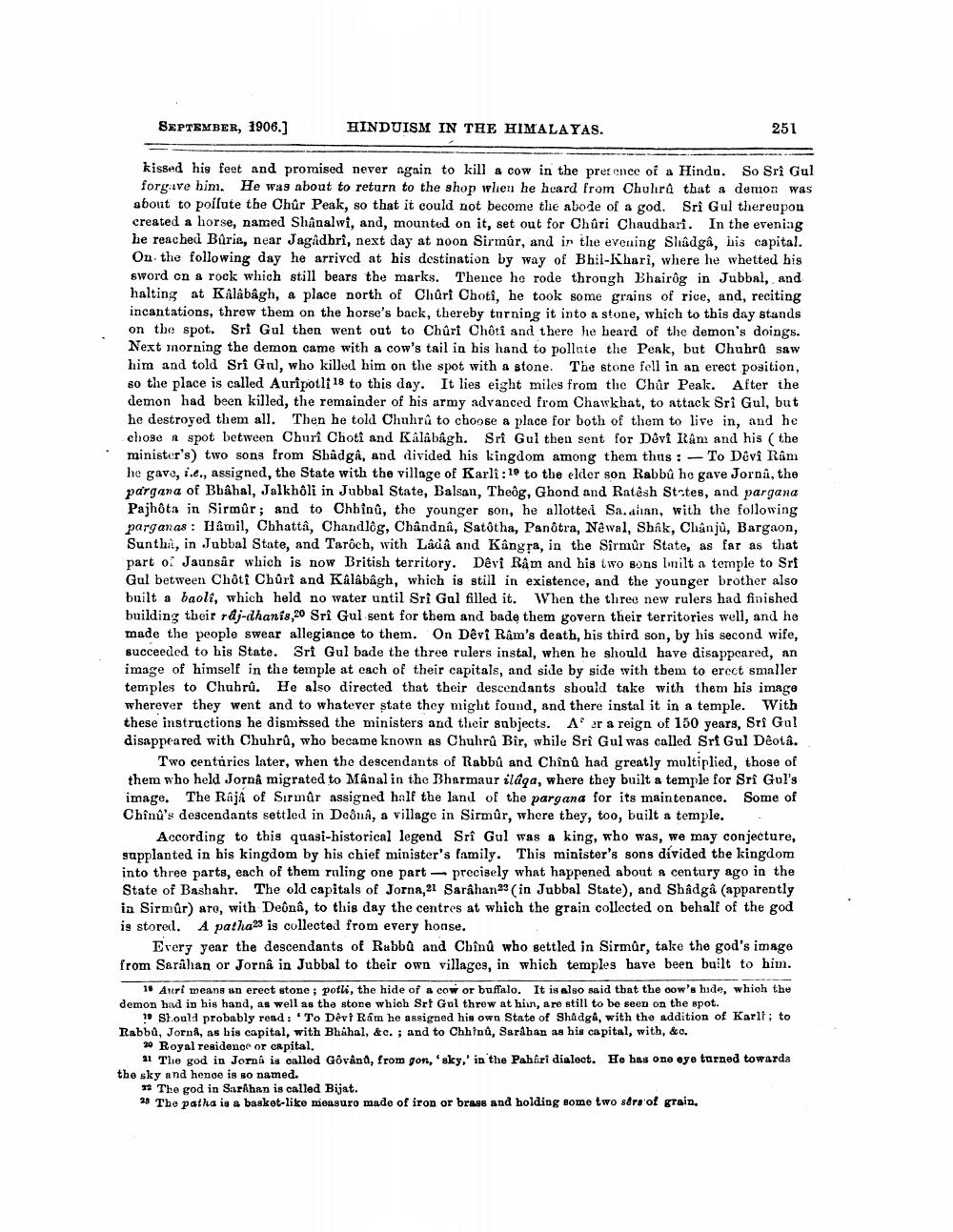________________
SEPTEMBER, 1906.]
HINDUISM IN THE HIMALAYAS.
251
kissed his feet and promised never ngain to kill a cow in the presence of a Hindu. So Sri Gul forgive him. He was about to return to the shop when he heard from Chuhra that a demon was about to poilute the Chûr Peak, so that it could not become the abode of a god. Sri Gul thereupon created a horse, named Shânalwi, and, mounted on it, set out for Chûri Chaudhari. In the evening he reached Buria, near Jagadbri, next day at noon Sirmûr, and in the evening Shadga, his capital. On the following day he arrived at his destination by way of Bhil-Khari, where he whetted his sword on a rock which still bears the marks. Thence ho rode through Bhairóg in Jubbal, and halting at Kalâbâgh, a place north of Chûri Choti, he took some grains of rice, and, reciting incantations, threw them on the horse's back, thereby turning it into a stone, which to this day stands on the spot. Sri Gul then went out to Chûri Chôti and there he heard of the demon's doings. Next morning the demon came with a cow's tail in his hand to pollate the Penk, but Chuhra saw him and told Sri Gul, who killed him on the spot with a stone. The stone fell in an erect position, so the place is called Auripotli 18 to this day. It lies eight miles from the Chûr Peak. After the demon had been killed, the remainder of his army advanced from Chawkhat, to attack Sri Gul, but he destroyed them all. Then he told Chuhrů to choose a place for both of them to live in, and he chose a spot between Churi Choti and Kalabagh. Sri Gul then sent for Dávi Ram and his (the minister's) two sons from Shadgâ, and divided his kingdom among them thus: - To Dêvî Râm he gave, i.e., assigned, the State with the village of Karlî:19 to the elder son Rabbû he gave Jorna, the pargana of Bhâhal, Jalkhôli in Jubbal State, Balsan, Theôg, Ghond and Ratesh States, and pargana Pajhôta in Sirmûr; and to Chbînû, the younger son, he allotted Sa.ahan, with the following parganas : Hamil, Chhatta, Chandløg, Chândnî, Satótha, Panôtra, Nêwal, Shak, Chanju, Bargaon, Sunthii, in Jubbal State, and Tarôch, with Lâdâ and Kangra, in the Sîrmûr State, as far as that part of Jaunsar which is now British territory. Devi Ram and his two sons limilt a temple to Srf Gul between Chôti Chûri and Kalâbâgh, which is still in existence, and the younger brother also built a baoli, which held no water until Sri Gal filled it. When the three new rulers had finished building their ráj-dhanis,20 Sri Gul sent for them and bade them govern their territories well, and he made the people swear allegiance to them. On Devi Râm's death, his third son, by his second wife, succeeded to his State. Sri Gul bade the three rulers instal, when he should have disappeared, an image of himself in the temple at each of their capitals, and side by side with them to erect smaller temples to Chuhrû. He also directed that their descendants should take with them his image wherever they went and to whatever state they might found, and there instal it in a temple. With these instructions he dismissed the ministers and their subjects. Ao ar a reign of 150 years, Sri Gul disappeared with Chuhrû, who became known as Chuhrû Bir, while Sri Gul was called Sri Gul Deota.
Two centúrics later, when the descendants of Rabbû and Chîn û had greatly multiplied, those of them who held Jornâ migrated to Manal in the Bharmaur ilága, where they built a temple for Sri Gul's image. The Raja of Sırmûr assigned half the land of the pargana for its maintenance. Some of Chinu's descendants settled in Deônâ, a village in Sirmûr, where they, too, built a temple.
According to this quasi-historical legend Sri Gul was a king, who was, we may conjecture, supplanted in his kingdom by his chief minister's family. This minister's sons dívided the kingdom into three parts, each of them ruling one part - precisely what happened about a century ago in the State of Bashahr. The old capitals of Jorna 21 Sarahan2(in Jubbal State), and Shadga (apparently in Sirmûr) are, with Deônâ, to this day the centres at which the grain collected on behalf of the god is stored. A patha23 is collected from every honse.
Every year the descendants of Rabbû and Chînû who settled in Sirmûr, take the god's image from Sarahan or Jorna in Jubbal to their own villages, in which temples have been built to him.
19 Auri means un erect stone; potui, the hide of a cow or buffalo. It is also said that the cow's hide, whioh the demon had in his hand, as well as the stone which Srt Gul threw at hiun, are still to be seen on the spot.
10 Should probably read : 'To Devi Ram he assigned his own State of Shadga, with the addition of Karit; to Rabbû, Jorn, as his capital, with Bhahal, &c.; and to Chhina, Sardhan as his capital, with, &c.
20 Royal residence or capital.
11 The god in Jorna is called Gôvând, from gon, sky,' in the Pahiri dialect. He has one oye turned towards the sky and hence is so named.
2 The god in Sardhan is called Bijat. 25 The patha is a basket-like mionguro made of iron or brass and holding some two sérs of grain,




